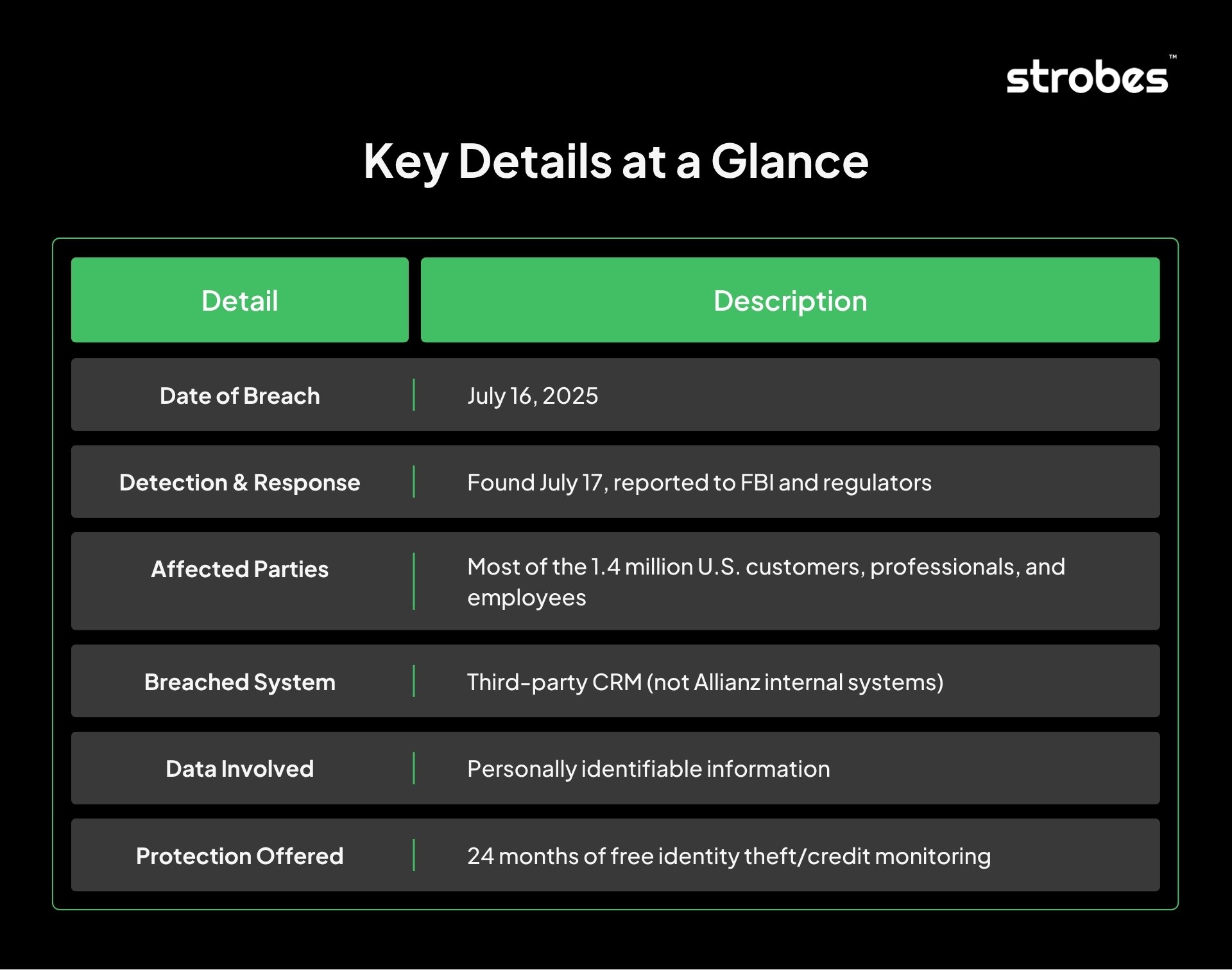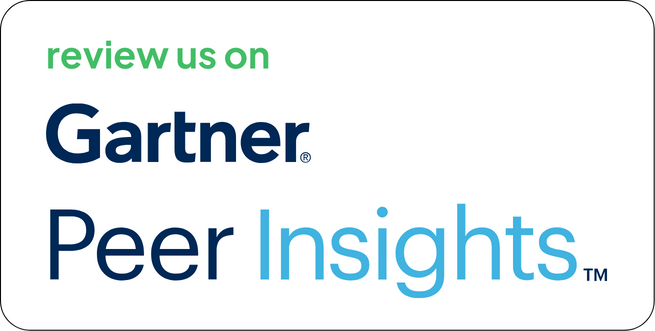Hackers have accessed personal information tied to most of the 1.4 million customers of Allianz Life Insurance Company of North America, according to a statement issued by its parent company.
On July 16, 2025, a malicious threat actor gained access to a third-party cloud-based CRM system used by Allianz Life. Allianz confirmed that the attacker used social engineering tactics to gain access.
As a result, personally identifiable information (PII) belonging to a large portion of customers, financial professionals, and select employees was exposed. The breach specifically impacted Allianz Life’s U.S. operations and did not extend to other entities within the group.
This blog post examines a data breach at Allianz Life, detailing the compromise method, the exposed information, and key lessons for companies handling sensitive data across distributed systems.
How the Breach Occurred
The breach didn’t result from an attack on Allianz Life’s own networks. Instead, cybercriminals leveraged sophisticated social engineering tactics to access a third-party, cloud-based customer relationship management (CRM) system. By targeting human vulnerabilities rather than technological ones, hackers bypassed many conventional security barriers.
- Entry was limited to the vendor’s system. Allianz’s internal IT and policy administration systems remained untouched.
- The attack was detected promptly, on July 17, barely a day after it began. The company quickly notified federal investigators, including the FBI, and regulatory authorities.
What Data Was Compromised?
The data breach at Allianz Life had far-reaching consequences in terms of the sensitive information exposed:
- Affected Individuals: The breach impacted the majority of Allianz Life’s approximately 1.4 million U.S. policyholders. Additionally, personal information belonging to various financial professionals connected to Allianz Life, as well as some employees, was also compromised.
- Types of Data Exposed: Although Allianz Life has not disclosed every specific detail, the compromised information generally includes personally identifiable information (PII). This typically covers names, addresses, dates of birth, Social Security numbers, contact details, insurance policy information, and possibly other sensitive financial data.
- Limitations of the Breach: It’s important to note that the breach was isolated to a third-party cloud-based customer relationship management (CRM) system and did not affect Allianz Life’s internal networks or other global Allianz subsidiaries.
Company Response and Remediation Efforts
Allianz Life’s response followed cybersecurity best practices:
- Containment and Investigation: Swift action was taken to contain the breach and begin a thorough investigation alongside law enforcement and specialized cyber incident response teams.
- Regulatory Notification: All affected customers, professionals, and employees will be notified directly. Notification efforts are scheduled to start on August 1, 2025.
- Support for Victims: Allianz Life is offering 24 months of complimentary identity theft protection and credit monitoring to all impacted individuals.
The cybercrime group “ShinyHunters” is suspected to be involved, although this has not been officially confirmed as investigations continue.
Why This Incident Matters
1. Highlighting Third-Party and Supply Chain Vulnerabilities
- Most organizations today rely heavily on cloud services, vendors, and external partners to manage data and operations.
- Data breach at Allianz Life illustrates how attackers are increasingly exploiting these third-party relationships, which often have weaker security controls than primary companies.
- It serves as a wake-up call that a company’s cybersecurity is only as strong as its most vulnerable partner.
2. The Evolving Nature of Cyberattacks
- Unlike traditional brute-force or malware attacks, this breach hinged on manipulating human behavior rather than technical defenses.
- Attackers used sophisticated social engineering tactics to gain access, showcasing how easily trust and human error can be weaponized.
- This emphasizes the critical need for continuous employee training and advanced monitoring of user activities.
3. Consumer Trust and Reputational Risks in the Financial Sector
- Trust is paramount in finance and insurance, where customers entrust companies with highly sensitive data and financial futures.
- Large-scale breaches erode that trust, potentially causing customers to reconsider their relationship with the firm and affecting market reputation.
- It also impacts intermediaries such as financial advisors, whose credibility may be questioned.
4. Regulatory and Legal Consequences Will Shape Industry Practices
- Incidents like this prompt investigations by regulators (state attorneys general, SEC, insurance commissioners) and can lead to costly fines and mandates for stronger controls.
- They also increase scrutiny on vendor risk management policies across the industry, likely influencing tighter compliance requirements and audit processes.
5. Financial and Operational Impacts on Allianz Life
- Beyond direct remediation costs (investigations, legal counsel, credit monitoring services), Allianz Life faces potential operational disruptions and heightened insurance premiums.
- There may also be increased investments in cybersecurity infrastructure and cybersecurity risk management, impacting the company’s bottom line.
6. Broader Implications for Cybersecurity Strategy and Defense
- Data breach at Allianz Life reinforces that cybersecurity is a multidimensional challenge requiring holistic approaches, technical defenses, human factors consideration, vendor oversight, and incident preparedness.
- It highlights the importance of layered security models, multi-factor authentication, and continuous threat intelligence sharing.
7. Increased Awareness for Consumers and Businesses Alike
- Customers affected understand the importance of monitoring credit reports, enrolling in identity protection, and recognizing phishing threats.
- Other companies are reminded to reassess their own cybersecurity posture, especially regarding third-party risks, to prevent similar occurrences.
Trusted by leading enterprises like, GHX, Zoho, Darwinbox, Tricenties, and SHL
Strobes helped organizations continuously manage threats, reduce vulnerabilities, and stay compliant, powered by AI-driven security expertise.
What Should Customers Do?
If you’re an Allianz Life customer, financial professional, or employee who suspects you might be affected:
- Watch for Communications: Look out for direct notifications from Allianz Life in the coming days.
- Activate Free Protections: Take advantage of the credit monitoring and identity theft protection being offered.
- Stay Alert: Monitor your financial accounts and credit reports for unusual activity, and consider placing a fraud alert or credit freeze if your Social Security number was exposed.
Key Details at a Glance

The digital transformation has led most large enterprises to rely on a sprawling ecosystem of partners: cloud software vendors, IT service companies, data analytics tools, and more. Each of these connections creates potential points of entry for attackers. In data breach at Allianz Life’s case, it was completely outside their internal network, showing that even companies with rigorous internal defenses are only as strong as their least-protected partner.
Best Practices and Legal Duties
Detection and Notification
- Prompt Disclosure: Allianz Life’s rapid public disclosure to customers, authorities, and regulators reflects a strong industry best practice and legal imperative. Many states (and federal regulations) now require notification as soon as a breach is confirmed, especially when PII may have been accessed.
- Transparency: Clearly explaining the breach where it occurred, what was (and was not) affected, and how customers would be protected helps maintain consumer trust even in crisis.
Support and Remediation
- Offering Identity Protection: Allianz Life responded by providing 24 months of free credit monitoring and identity theft protection. This practical support aims to help customers detect and prevent fallout from the breach.
- Ongoing Investigation: Alongside notification, the company continues to investigate, both to close vulnerabilities and to work with law enforcement on tracing the perpetrators. The “ShinyHunters” group is suspected in the attack, but this has not been formally confirmed.
Conclusion
As the investigation continues, data breach at Allianz Life remains a critical case study on third-party and cloud vendor risk management. For affected individuals, vigilance and prompt action are essential to minimize the possible fallout from this unfortunate event. If in doubt, don’t hesitate to contact Allianz Life’s customer support hotline for help navigating your next steps.
For organizations looking to proactively strengthen their third-party risk posture, book a free demo to explore how automated security solutions can help.
Related Reads:








